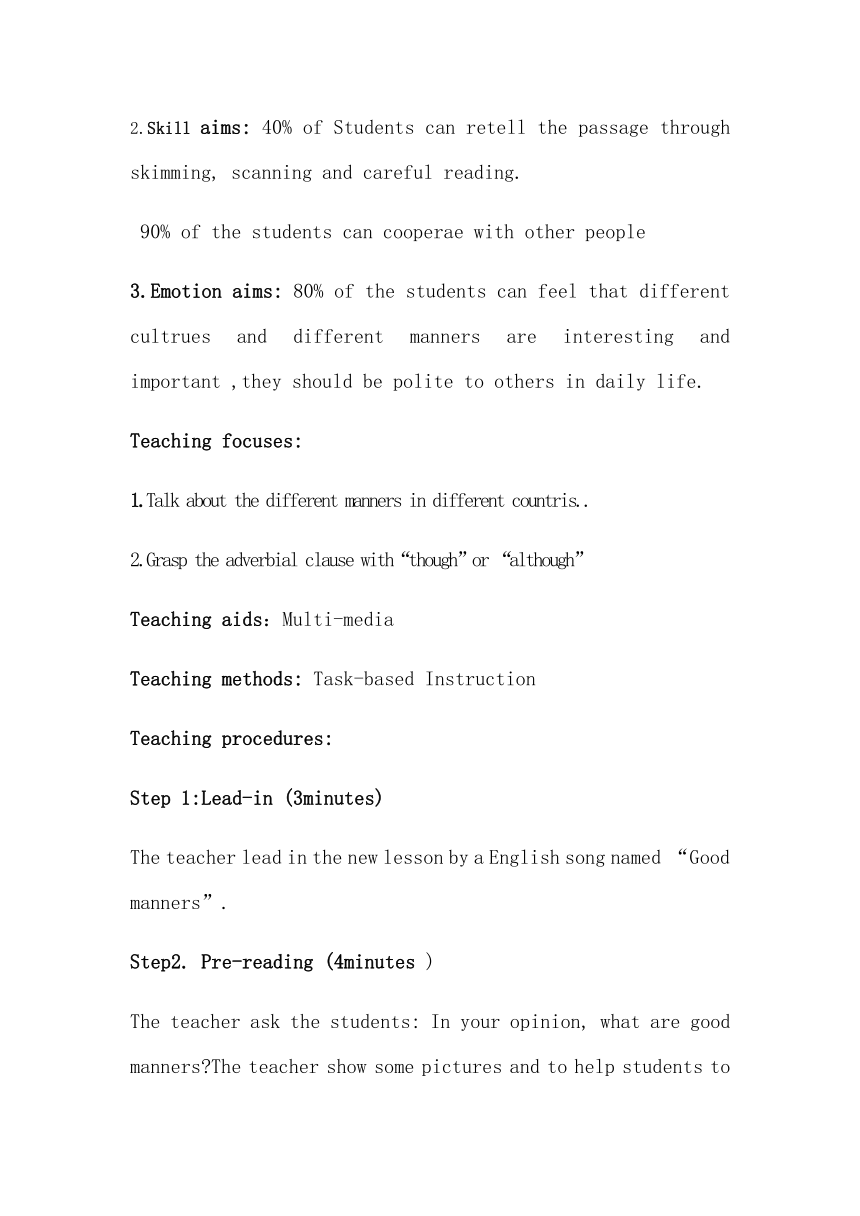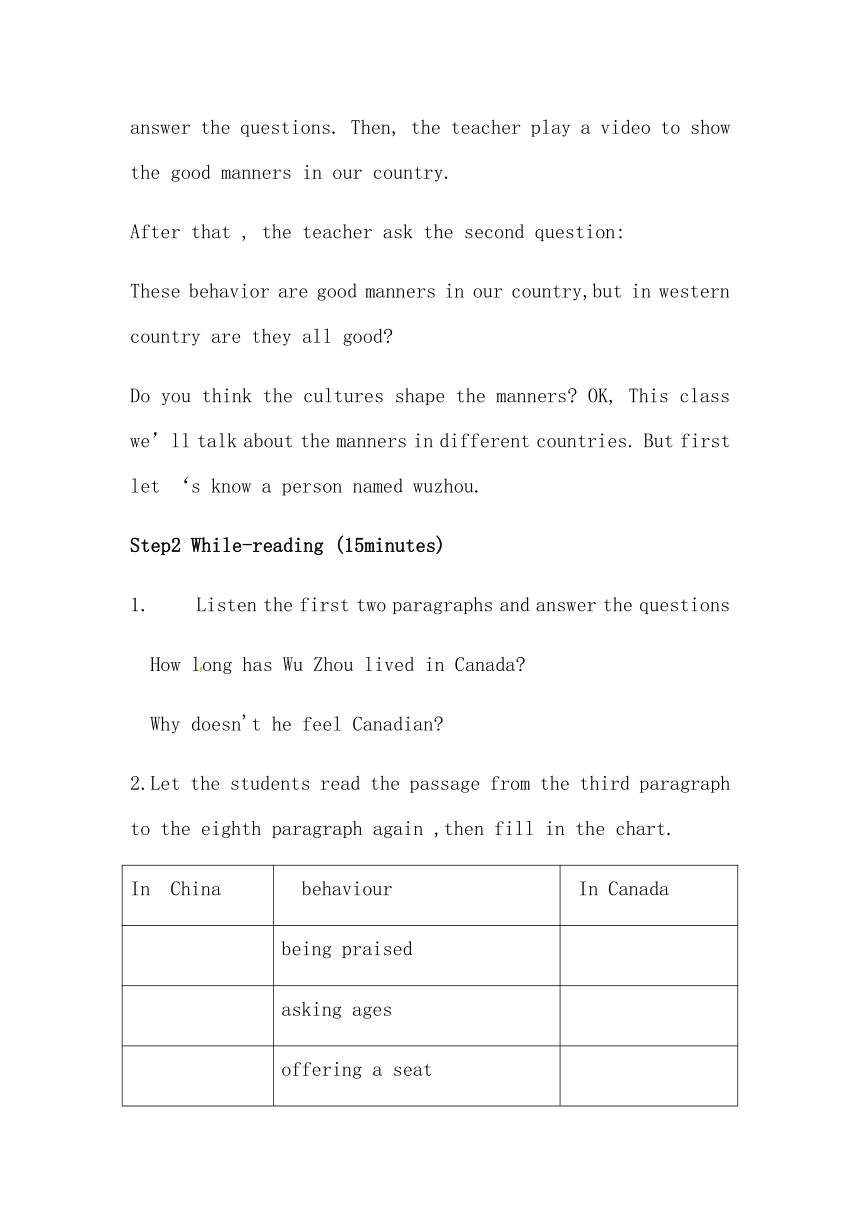Unit 8 Culture Shapes Us Lesson 45 Different Manners 教学设计
文档属性
| 名称 | Unit 8 Culture Shapes Us Lesson 45 Different Manners 教学设计 |  | |
| 格式 | zip | ||
| 文件大小 | 36.5KB | ||
| 资源类型 | 教案 | ||
| 版本资源 | 冀教版 | ||
| 科目 | 英语 | ||
| 更新时间 | 2020-05-28 22:10:13 | ||
图片预览



文档简介
Lesson
45
Different
Manners教学设计
课题:Lesson
45
Different
Manners
课型:
New
lesson(Reading
lesson)
教学资源分析:本课的中心话题是“谈论中西文化的差异决定了不同的礼仪”。《英语课程标准》(2011年版)要求学生在学习和日常交际中能注意到中外文化的差异。教师将对教材进行整合,把阅读课同听力练习结合起来,并对该文章内容进行了拓展和升华。
另外,本节课准备采用音频材料、视频材料,这些资料的内容与课文内容紧密相关,并能激发学生的学习兴趣。
学情分析:九年级的学生求知欲旺盛,课上能积极与老师配合,主动参加课堂活动。九年级学生阅读有了一定的基础但仍然是是良莠不齐,对本课内容掌握程度不一。课上应多采用丰富多彩的小组活动激活学习气氛,争取最大程度地辐射到每个学生。
Teaching
aims:
1.
Knowledge
aims:
70%
of
the
students
can
get
the
main
idea
and
the
specific
information
of
the
passage.
60%
of
the
students
can
master
the
usage
of
the
adverbial
clause
with
“though”
or
“although”
2.Skill
aims:
40%
of
Students
can
retell
the
passage
through
skimming,
scanning
and
careful
reading.
90%
of
the
students
can
cooperae
with
other
people
3.Emotion
aims:
80%
of
the
students
can
feel
that
different
cultrues
and
different
manners
are
interesting
and
important
,they
should
be
polite
to
others
in
daily
life.
Teaching
focuses:
1.Talk
about
the
different
manners
in
different
countris..
2.Grasp
the
adverbial
clause
with“though”or
“although”
Teaching
aids:Multi-media
Teaching
methods:
Task-based
Instruction
Teaching
procedures:
Step
1:Lead-in
(3minutes)
The
teacher
lead
in
the
new
lesson
by
a
English
song
named
“Good
manners”.
Step2.
Pre-reading
(4minutes
)
The
teacher
ask
the
students:
In
your
opinion,
what
are
good
manners?The
teacher
show
some
pictures
and
to
help
students
to
answer
the
questions.
Then,
the
teacher
play
a
video
to
show
the
good
manners
in
our
country.
After
that
,
the
teacher
ask
the
second
question:
These
behavior
are
good
manners
in
our
country,but
in
western
country
are
they
all
good?
Do
you
think
the
cultures
shape
the
manners?
OK,
This
class
we’ll
talk
about
the
manners
in
different
countries.
But
first
let
‘s
know
a
person
named
wuzhou.
Step2
While-reading
(15minutes)
1.
Listen
the
first
two
paragraphs
and
answer
the
questions
How
long
has
Wu
Zhou
lived
in
Canada?
Why
doesn't
he
feel
Canadian?
2.Let
the
students
read
the
passage
from
the
third
paragraph
to
the
eighth
paragraph
again
,then
fill
in
the
chart.
In
China
behaviour
In
Canada
being
praised
asking
ages
offering
a
seat
Paying
for
meals
Put
food
on
guests’plate
giving
tips
3.Teacher
ask
the
students
the
question
of”
Why
Wuzhou
has
many
good
friends
in
Canada,
though
Canadian
culture
different
from
Chinese
culture.”
Have
the
students
read
the
last
paragraph
and
find
out
the
answer.
4.Have
the
students
to
find
out
the
topic
sentence
of
the
passage
.
Step3.Post-reading
(5minutes)
1.
Let
students
retell
the
difference
feeling
of
the
six
behavior
between
China
and
Canada.
2.
Work
in
pairs
and
discuss:
What
culture
differences
besides
the
ones
already
discussed,
have
you
noticed
between
China
and
English-speaking
countries?
Share
your
ideas
with
your
classmates.
3.Show
the
pictures
of
“people
all
of
the
world”to
the
students
and
let
them
understand
the
meaning
of
the
passage
deeply.
4.Teach
the
adverbial
clause
with
“though”
or
“although”
Step
4.Summary
and
Homework
(2minutes)
Summary:
The
teacher
conclude
what
they
have
learned
today.
Homework:
(1
minute)
1.
Make
a
project
about
different
manners
in
one
of
the
countries
you’d
like
to
travel
to.
2.
Finish
the
exercises
of
the
lesson.
Board
Design
In
China
behaviour
In
Canada
Be
modest
being
praised
say
"Thanks"
and
be
confident
common
asking
ages
Private,not
polite
polite
offering
a
seat
Feel
embarrassed
Take
turns
Paying
for
meals
Share
the
cost
polite
Put
food
on
guests’plate
Not
polite
seldom
giving
tips
always
Topic
sentence:
Understanding
cultural
differences
really
helps
us
to
understand
each
other,
live
together
and
work
together.
45
Different
Manners教学设计
课题:Lesson
45
Different
Manners
课型:
New
lesson(Reading
lesson)
教学资源分析:本课的中心话题是“谈论中西文化的差异决定了不同的礼仪”。《英语课程标准》(2011年版)要求学生在学习和日常交际中能注意到中外文化的差异。教师将对教材进行整合,把阅读课同听力练习结合起来,并对该文章内容进行了拓展和升华。
另外,本节课准备采用音频材料、视频材料,这些资料的内容与课文内容紧密相关,并能激发学生的学习兴趣。
学情分析:九年级的学生求知欲旺盛,课上能积极与老师配合,主动参加课堂活动。九年级学生阅读有了一定的基础但仍然是是良莠不齐,对本课内容掌握程度不一。课上应多采用丰富多彩的小组活动激活学习气氛,争取最大程度地辐射到每个学生。
Teaching
aims:
1.
Knowledge
aims:
70%
of
the
students
can
get
the
main
idea
and
the
specific
information
of
the
passage.
60%
of
the
students
can
master
the
usage
of
the
adverbial
clause
with
“though”
or
“although”
2.Skill
aims:
40%
of
Students
can
retell
the
passage
through
skimming,
scanning
and
careful
reading.
90%
of
the
students
can
cooperae
with
other
people
3.Emotion
aims:
80%
of
the
students
can
feel
that
different
cultrues
and
different
manners
are
interesting
and
important
,they
should
be
polite
to
others
in
daily
life.
Teaching
focuses:
1.Talk
about
the
different
manners
in
different
countris..
2.Grasp
the
adverbial
clause
with“though”or
“although”
Teaching
aids:Multi-media
Teaching
methods:
Task-based
Instruction
Teaching
procedures:
Step
1:Lead-in
(3minutes)
The
teacher
lead
in
the
new
lesson
by
a
English
song
named
“Good
manners”.
Step2.
Pre-reading
(4minutes
)
The
teacher
ask
the
students:
In
your
opinion,
what
are
good
manners?The
teacher
show
some
pictures
and
to
help
students
to
answer
the
questions.
Then,
the
teacher
play
a
video
to
show
the
good
manners
in
our
country.
After
that
,
the
teacher
ask
the
second
question:
These
behavior
are
good
manners
in
our
country,but
in
western
country
are
they
all
good?
Do
you
think
the
cultures
shape
the
manners?
OK,
This
class
we’ll
talk
about
the
manners
in
different
countries.
But
first
let
‘s
know
a
person
named
wuzhou.
Step2
While-reading
(15minutes)
1.
Listen
the
first
two
paragraphs
and
answer
the
questions
How
long
has
Wu
Zhou
lived
in
Canada?
Why
doesn't
he
feel
Canadian?
2.Let
the
students
read
the
passage
from
the
third
paragraph
to
the
eighth
paragraph
again
,then
fill
in
the
chart.
In
China
behaviour
In
Canada
being
praised
asking
ages
offering
a
seat
Paying
for
meals
Put
food
on
guests’plate
giving
tips
3.Teacher
ask
the
students
the
question
of”
Why
Wuzhou
has
many
good
friends
in
Canada,
though
Canadian
culture
different
from
Chinese
culture.”
Have
the
students
read
the
last
paragraph
and
find
out
the
answer.
4.Have
the
students
to
find
out
the
topic
sentence
of
the
passage
.
Step3.Post-reading
(5minutes)
1.
Let
students
retell
the
difference
feeling
of
the
six
behavior
between
China
and
Canada.
2.
Work
in
pairs
and
discuss:
What
culture
differences
besides
the
ones
already
discussed,
have
you
noticed
between
China
and
English-speaking
countries?
Share
your
ideas
with
your
classmates.
3.Show
the
pictures
of
“people
all
of
the
world”to
the
students
and
let
them
understand
the
meaning
of
the
passage
deeply.
4.Teach
the
adverbial
clause
with
“though”
or
“although”
Step
4.Summary
and
Homework
(2minutes)
Summary:
The
teacher
conclude
what
they
have
learned
today.
Homework:
(1
minute)
1.
Make
a
project
about
different
manners
in
one
of
the
countries
you’d
like
to
travel
to.
2.
Finish
the
exercises
of
the
lesson.
Board
Design
In
China
behaviour
In
Canada
Be
modest
being
praised
say
"Thanks"
and
be
confident
common
asking
ages
Private,not
polite
polite
offering
a
seat
Feel
embarrassed
Take
turns
Paying
for
meals
Share
the
cost
polite
Put
food
on
guests’plate
Not
polite
seldom
giving
tips
always
Topic
sentence:
Understanding
cultural
differences
really
helps
us
to
understand
each
other,
live
together
and
work
together.
同课章节目录
- Unit 7 Work for Peace
- Lesson 37 Don't Fight!
- Lesson 38 Making School a Better Place
- Lesson 39 The Dove and the Olive Branch
- Lesson 40 The UN—Power of Words
- Lesson 41 Jenny's Good Advice
- Lesson 42 Peace at Last
- Unit Review
- Unit 8 Culture Shapes Us
- Lesson 43 A Visit to Chinatown
- Lesson 44 Popular Sayings
- Lesson 45 Different Manners
- Lesson 46 Home to Many Cultures
- Lesson 47 Good Manners
- Lesson 48 Supper with the Bradshaws
- Unit Review
- Unit 9 Communication
- Lesson 49 Get Along with Others
- Lesson 50 Tips for Good Communication
- Lesson 51 What Could Be Wrong?
- Lesson 52 The Power of a Smile
- Lesson 53 Working in Groups
- Lesson 54 How Embarrassing!
- Unit Review
- Unit 10 Get Ready for the Future
- Lesson 55 Look into the Future
- Lesson 56 Manage Your Time
- Lesson 57 Best Wishes
- Lesson 58 Ms.Liu's Speech
- Lesson 59 Keep Your Choices Open
- Lesson 60 Get a Good Education
- Unit Review
